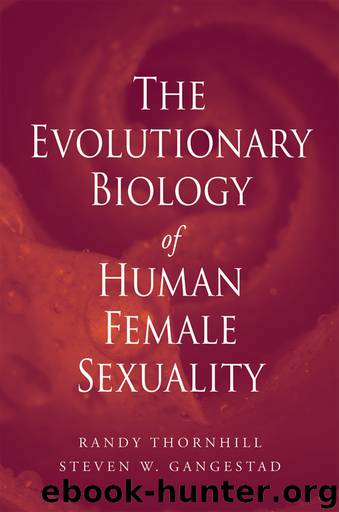The Evolutionary Biology of Human Female Sexuality by Thornhill Randy; Gangestad Steven W.;

Author:Thornhill, Randy; Gangestad, Steven W.;
Language: eng
Format: epub
Publisher: Oxford University Press
Published: 2008-04-04T04:00:00+00:00
Estrus Will (Nearly) Always Accompany Extended Female Sexuality
In many species, females have estrus with no accompanying extended female sexuality. The converse, however, should occur rarely, if ever: Females should not possess extended sexuality without estrus. Female extended sexuality makes little adaptive sense without estrus. Female choice adaptations of estrus provide control over paternity, which allows extended sexuality to reap male nongenetic material benefits provided by an unsuitable sire at low to zero probability of fertilization by him. Extended female sexuality, in other words, will be favorably selected only when there is adaptation that functions to control sire choice in place in the female’s reproductive repertoire.
Because males in species with extended female sexuality imperfectly discriminate female fertile cycle state from infertile states, it behooves them to copulate when opportunity presented by female sexual interest arises, irrespective of the female’s cycle phase. Hence, when females are available for mating across their cycles, extended male sexual competition occurs. Selection then can favor females that choose mates during low to zero fertility cycle phases, but typically females will use different criteria when exercising choice at these times than during estrus. As we discuss in the next chapter, the most detailed support for different female choice criteria during extended sexuality than during estrus, is found in research on human females.
In some bird species with biparental care, females do not appear to prefer mating with males other than primary mates, even when fertile. In these species, adaptive sire choice may simply constitute choice of the social partner, regardless of his relative genetic quality, and female sexuality during the fertile phase may differ minimally from female sexuality during extended sexuality. As we mentioned earlier, implications of choosing a sire other than a pair-bonded partner for the flow of nongenetic material benefits received by that partner cannot be ignored if female choice of a sire during estrus is to be adaptive; in some cases, the implications of losing a partner’s investment may outweigh any potential benefits derived from seeking another male’s genes for offspring. We discuss possible examples in chapters 10 and 12. As we also discuss in these chapters, however, species in which females possess no adaptation to choose sires other than social partners are relatively rare among socially monogamous birds. Furthermore, humans do not qualify as such a species.
Download
This site does not store any files on its server. We only index and link to content provided by other sites. Please contact the content providers to delete copyright contents if any and email us, we'll remove relevant links or contents immediately.
Sapiens: A Brief History of Humankind by Yuval Noah Harari(13987)
Sapiens by Yuval Noah Harari(5122)
Homo Deus: A Brief History of Tomorrow by Yuval Noah Harari(4689)
Pale Blue Dot by Carl Sagan(4613)
Livewired by David Eagleman(3534)
Origin Story: A Big History of Everything by David Christian(3472)
Brief Answers to the Big Questions by Stephen Hawking(3239)
Inferior by Angela Saini(3151)
Origin Story by David Christian(2991)
The Gene: An Intimate History by Siddhartha Mukherjee(2927)
Signature in the Cell: DNA and the Evidence for Intelligent Design by Stephen C. Meyer(2875)
The Evolution of Beauty by Richard O. Prum(2868)
Aliens by Jim Al-Khalili(2703)
How The Mind Works by Steven Pinker(2612)
A Short History of Nearly Everything by Bryson Bill(2506)
Sex at Dawn: The Prehistoric Origins of Modern Sexuality by Ryan Christopher(2413)
From Bacteria to Bach and Back by Daniel C. Dennett(2389)
Endless Forms Most Beautiful by Sean B. Carroll(2350)
Who We Are and How We Got Here by David Reich(2342)
